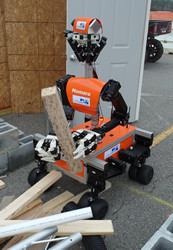Trending Science: Three European teams demonstrate progress in emergency response robotics since Fukushima disaster
The Defense Advanced Research Projects Agency (DARPA) competition, to be held in California in the US, offers human-robot teams from across the world the opportunity to demonstrate capabilities that could enable them to provide assistance in future natural and man-made disasters. According to Scientific American, the competition aims to ensure that robots can take the lead in emergency response situations in a way that they could not following the nuclear disaster at Fukushima in 2011. To qualify for the DRC Finals, the teams had to submit videos showing successful completion of five sample tasks: engage an emergency shut-off switch, get up from a prone position, locomote ten meters without falling, pass over a barrier, and rotate a circular valve 360 degrees. Having successfully passed this round, the WALK-MAN team representing Italy and the Hector Darmstadt and NimbRo Rescue teams representing Germany will be among the challengers facing off against teams from Japan, China, South Korea and the US in a bid to win 3.5 million dollars (EUR 3.1 million) in prizes and inspire further advancements in the field of robotics. The limitations of emergency response robots – including in relation to mobility and level of autonomy – meant that they could only play a ‘marginal’ role in certain disaster situations in the past. Scientific American notes, ‘Nowhere was this more painfully obvious than in Japan four years ago, after a small squadron of robots was sent to assist workers at the devastated Fukushima Daiichi nuclear plant. The machines spent a good deal of time on the sidelines, leaving humans to do the most hazardous work.’ The Fukushima experience was a learning curve for the robotics community. It became clear that in situations like this robots need – among other things – radiation shielding in order to ensure that communication is not disrupted. Scientific American notes, ‘Robots from iRobot and Honeywell – both of which had been developed using DARPA funds – eventually did help with some damage assessment and cleanup – and some continue to operate at Fukushima – but they were of limited use during the emergency when the site was at its most dangerous.’ In conversation with Scientific American, Gill Pratt, DARPA programme manager for the competition, noted, ‘Fukushima was really a great inspiration for us because we don’t know what the next disaster is going to be, but we know that we have to develop technology to help us to address these kinds of disasters.’ The DARPA teams sees the high level of international interest in the competition as proof of the value of robots in emergency response situations. Ms Pratt adds, ‘The diverse participation indicates not only a general interest in robotics, but also the priority many governments are placing on furthering robotic technology … We’re looking forward to seeing how the teams ensure the robustness of their robots against falls, strategically manage battery power, and build enough partial autonomy into the robots to complete the challenge tasks despite DARPA deliberately degrading the communication links between robots and operators.’ For further information, please visit: http://www.darpa.mil/NewsEvents/Releases/2015/03/05.aspx - WALK-MAN sets the bar high for DARPA’s Robotics Challenge Finals
Countries
China, Germany, Italy, Japan, South Korea, United States



